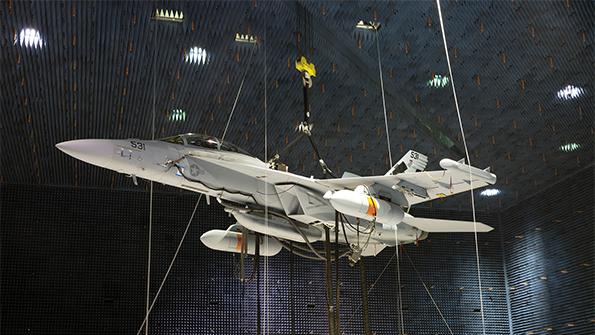
A new era of long-range, airborne electronic attack is finally moving from testing to the operational community of the U.S. military.
A standoff jamming system, first proposed in 2004 to begin replacing another system originally fielded in 1971, is now entering production after a nearly two-decade-long gestation in research and development.
- Navy awards first NGJ-MB production contract
- EA-18G Block II planned to enter service in five years
As the powerful new pod comes into service, the changing nature of electronic warfare and the physics challenges posed by the standoff jamming mission are driving development of a Block II version of the Boeing EA-18G. The Navy seeks to optimize the host platform to harness the full potential of a half-century leap in radar and communications jamming technology.
The Navy awarded Raytheon a nearly $172 million contract on July 5 for the procurement of three low-rate initial-production shipsets of the ALQ-249 Next-Generation Jammer Mid-Band (NGJ-MB) pod, which will be carried by the Boeing EA-18G.
“This capability is a game changer for our warfighters and the Airborne Electronic Attack community,” says Rear Adm. Shane Gahagan, program executive officer for tactical aircraft programs.
The NGJ-MB, a pod that features an active, electronically scanned array (AESA) with highly efficient gallium-nitride (GaN) semiconductors, is now expected to enter service in fiscal 2022. It will be followed by the L3Harris NGJ Low-Band a year later and an NGJ High-Band, which has yet to be competed, in the future.
Ultimately, the trio of AESA-based pods will replace the five-pod ALQ-99 system, which the Navy introduced on the EA-6B Prowler 50 years ago.
Although the Navy approved an initial capabilities document in 2004 to launch the NGJ program, the production go-ahead decision 17 years later reflects only a relatively minor delay in the overall schedule. In 2004, the Navy anticipated the first NGJ-based capability would achieve initial operational capability in fiscal 2020. An aerodynamic drag problem discovered by Raytheon in 2017, however, caused a two-year delay to the pod redesign.
The EA-18G’s job is to protect Lockheed Martin F-35 and F-22 fighters flying far ahead of it by blinding an enemy’s fire control radars with a burst of electromagnetic noise transmitted by NGJ-MB pods. The role of any standoff jamming system is already challenging, so the new capability cannot come soon enough for operators.
The EA-18G’s position behind the aircraft poses a fundamental physics problem for an electronic warfare system. In order to react in real time to radar signals searching for the stealthy F-35 and F-22, the EA-18G’s ALQ-218 receivers and ALQ-249 transmitters would have to exceed the speed of light. Since doing so is physically impossible, the onboard techniques generator has to anticipate the enemy radar’s next move. The system can access a well-maintained library of enemy signals to plot its strategy, but that is becoming more difficult in a new era of software-defined radios that use increasingly sophisticated frequency-hopping techniques.
Those conditions imply several questions for a “next-generation jammer,” says Ernie Winston, senior manager for Raytheon’s Electronic Warfare Systems. “Can you anticipate what that guy is going to do next?” he adds. “Where do I think that signal is going to go? Can I put the piece of information into that victim array that I want to inflict on [it]? That’s an incredible challenge.”
The Navy has a new program of record to solve those problems. The current system has no way of responding if an unknown signal is detected by the EA-18G’s receivers. However, the Reactive Electronic Attack Measures (REAM) program is developing a capability to automatically identify and classify new signals as they are detected and recommend a jamming solution. The system operates by inferring how a new enemy signal works based on physics principles and information in the U.S. military’s threat libraries.
“In a nutshell, you know [a threat emitter] is operating outside of library characteristics, and the system would say, ‘OK, that’s acting like a fire-control radar,’ and adapt accordingly,” Winston says.
The REAM capability is scheduled to enter service as part of the EA-18G Block II in fiscal 2026, when the Navy’s airborne electronic attack fleet may have all three pods that will replace the ALQ-99 at its disposal.
